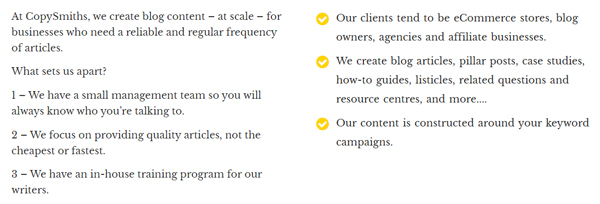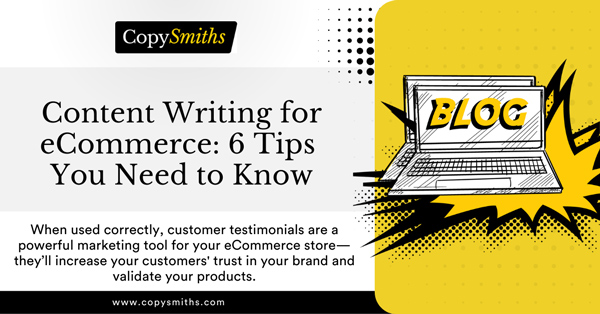You may have the best-designed eCommerce website or sell the best products amongst your competitors, but without great content to back these up, you’ll likely fail to achieve your desired ROI goals.
The content for your eCommerce blog is not just a bunch of words filling up pages—it’s what breathes life into your site.
Successful eCommerce stores understand the value of good content, hence the common phrase—content is king.
In fact, most buyers today buy products online without human interaction. They only read your content, engage, then make a purchase.
With the right content, your eCommerce site will:
- Witness a huge boost in traffic, increasing conversions
- Educate your visitors about your products, compelling them to share your content
- Evoke your visitors’ emotions, convincing them to buy your products
- Engage your audience and build loyalty and trust, converting them to buyers
Most eCommerce stores still haven’t mastered the art of good eCommerce content writing, hence not reaping the monetary benefits of the trillion-dollar industry.
But with these 6 tips, you can create quality, engaging, and persuasive content for your eCommerce store and get the most ROI.
Tip 1: Know Your Target Audience
It’s impossible to write content that relates to your audience if you don’t know who they are, what they need, and how your products will help them.
For effective eCommerce content marketing, you must give your readers a reason to read and prioritize your copy over other pressing tasks at hand.
You can only achieve this by knowing and writing for your target audience. This means you need to seek answers to such questions:
- Which customers would benefit most from your products? For instance, if you sell pet food, your target buyers will be pet parents.
- Where do your readers live? This lets you determine your shipping policy and durations.
- What other brands do they like? It informs you of your competitors.
- What are their main concerns? This lets you create solution-based content. For example, if they’re struggling with acne, they want content on fighting acne.
Understanding your audience and meeting their needs through your content gets them hooked. Only then can you transform them into long-term buyers.
But if you lack a clear picture of who your ideal buyers are, your content will still tumble no matter how creative and engaging it is.
Tip 2: Understand Your Uniqueness
Why should a potential customer purchase your products and not your competitor’s?
It’s unfair to expect your target buyers to be loyal to your brand without offering them a valid reason to be loyal. That’s why you need to identify your unique value proposition—whatever gives you a competitive advantage over others.
Once you know what sets you aside, you can “sell” that to your target audience.
When establishing your uniqueness, avoid words like “we’re the best” or “no one does it like us”—they’re cliche words with little to no impact.
Instead, show your customers what exactly makes you different. Explain to them how you’ll solve their problems and why they must seek your services or buy your products. This encourages them to convert in the long run.
In this example, we see what makes CopySmiths different from other content shops:
Tip 3: Tell Your Brand’s Story
What’s the story behind your eCommerce store?
In content marketing, storytelling engages your audience, draws them in, and makes them feel like part of your brand.
An “About Us” or “Our Story” page of your site should tell the readers your brand’s purpose, highlight its qualities, and enforce its reputation.
Through telling your brand’s story, target buyers begin to develop an emotional attachment to the brand and the people behind it, making it stick in their minds hours after leaving your site.
Remember you’re building a brand, not just selling products or providing services. So let your captivating story create your business’s narrative.
Your brand’s story needs to include:
- Your company’s mission
- Why you began the business
- Your products’ positive impact on the buyers
Expert Tip: As you share your brand’s story, make the customer your primary focus and tell them what they’ll achieve or experience by associating with your brand. Let them want to be part of your story.
Related: 6 Reasons Your Business Needs to Hire SEO Copywriting Services
Tip 4: Add Customer Testimonials
When used correctly, customer testimonials are a powerful marketing tool for your eCommerce store—they boost your customers’ trust in your brand and validate your products.
Additionally, posting success stories and happy comments from past customers helps build your brand’s credibility among prospective buyers who don’t know you yet. This attracts more visitors to your site, leading to higher conversions and sales.
There are numerous places and ways to incorporate customer testimonials to your eCommerce site:
- Home page: It’s the most commonly used. Most visitors will want to learn more about your company once on the home page, making it a great location to add the testimonials.
- Blog posts: Any visitor who reads your blogs is a potential buyer, so add short testimonials within the blogs.
- A customer testimonial page: Having an entire page dedicated to testimonials allows potential buyers to see many customers’ feedback on your products or services.
- Email marketing: Adding relevant testimonials to your emails during a campaign will build your brand’s credibility and increase conversions.
Here’s a customer testimonial from CopySmiths’ Testimonials page:
“The team was a joy to work with: highly responsive, innovative and full of intriguing multi-faceted ideas.” — Hilary, eCommerce Business
Tip 5: Pay Attention to Word Count
Besides testimonials, consider the number of your words.
Google views your audience as your main priority and wants them satisfied with your content.
However, a single line of text shoddily written is not enough to effectively explain your services to the reader.
Google’s algorithm demerits thin content and rewards well-researched, succinctly written content by ranking it high in search engines.
That’s why most successful eCommerce stores use long-form content (typically 1000+ words) to provide in-depth explanations of their products or services.
The table below shows the difference between short-form content and long-form content.
| Short-Form Content | Long-Form Content |
| Typically less than 1000 words | More than 1000 words |
| Quick and easy to digest thus doesn’t cover a topic in-depth | Dives deep into a topic and covers it in-depth |
| Effective on social media because it requires a short attention span | Effective as a blog post since it aims to educate and inform |
| Gives brief explanations of topics, thus not ranking high in search engines | Ranks better on search engines because of its depth |
Tip 6: Write Your Product Descriptions in Full
As visitors come to your site, remember their two main goals—buying and researching. If you want to meet both these needs, you can’t afford to provide half-baked product descriptions.
Yet most eCommerce store owners fall into this trap. They’ll leave out important details, making potential customers feel confused.
For instance, if you sell ladies’ bags, adding just the price and pictures isn’t enough, even if “pictures speak a thousand words”. You’ll need to provide your prospective buyers with details such as available colors, dimensions, type of material, and what makes your bags unique.
If your content lacks a detailed product description, you reduce the chances of your eCommerce site showing up in top search engines, since most product descriptions contain high-volume keywords.
Expert Tip: Provide your production descriptions in other languages using online translation services to cater to international clients and increase your brand’s reach.
Take Your eCommerce Content Writing to a New Level
Keeping your visitors engaged with compelling and well-written web content converts them to returning customers in no time.
But with your tight schedule as a business owner, creating and producing quality content for your site can be daunting.
Luckily, there’s a more convenient and timely way—seek copywriting services from an experienced, reputable content shop like CopySmiths.
With 20+ years of experience in eCommerce, we understand the importance of writing copy that sells and have managed to do so for multiple eCommerce sites. Our articles range from how-to guides and listicles to buying guides (and many more).
Even better, our work speaks for itself:
“It has been a pleasure working with the CopySmiths team–they are reliable, efficient, and great at curating high-quality content…” — Sander Tamm, e-student.org
So contact us today and take your site’s content to a higher level.
Share on LinkedIn:


